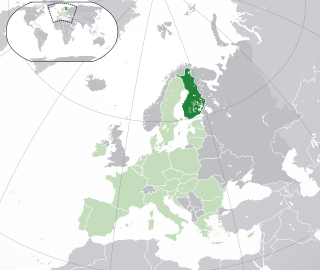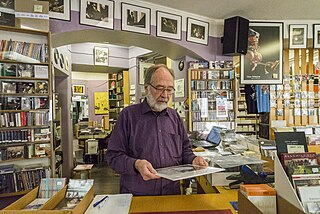Related Research Articles
Helsingin Sanomat, abbreviated HS and colloquially known as Hesari, is the largest subscription newspaper in Finland and the Nordic countries, owned by Sanoma. Except after certain holidays, it is published daily. Its name derives from that of the Finnish capital, Helsinki, where it is published. It is considered a newspaper of record for Finland.

Lappeenranta is a city and municipality in the region of South Karelia, about 30 kilometres from the Russian border and 64 kilometres (40 mi) from the town of Vyborg (Viipuri). It is situated on the shore of the Lake Saimaa in southeastern Finland, and is one of the most significant urban centers in the whole Saimaa region, along with the towns of Imatra, Mikkeli and Savonlinna. With approximately 73,000 inhabitants Lappeenranta is the 13th largest city in Finland, after incorporating the previous municipalities of Lappee and Lauritsala in 1967, Nuijamaa in 1989, Joutseno in 2009, and Ylämaa in 2010.

Lappeenranta-Lahti University of Technology LUT, better known by the abbreviation LUT University is a Finnish public research university which was established in 1969. The university's Lappeenranta campus is situated on the shore of lake Saimaa – the 4th largest lake in Europe. LUT University's second campus is in the Finnish city of Lahti. The university also has research units in the Finnish cities of Mikkeli and Kouvola, as well as a regional office in Brussels, Belgium.

Lesbian, gay, bisexual, and transgender (LGBT) rights in Finland are among the most advanced in the world. Both male and female same-sex sexual activity have been legal in Finland since 1971 with "promotion" thereof decriminalized and the age of consent equalized in 1999. Homosexuality was declassified as an illness in 1981. Discrimination based on sexual orientation in areas such as employment, the provision of goods and services, etc., was criminalized in 1995 and discrimination based on gender identity in 2005.

Länsimetro is an extension to the Helsinki Metro system in Finland, which opened on 18 November 2017. Länsimetro extends the system's two lines, M1 and M2, from Central Helsinki to the neighbouring city of Espoo. The new stretch continues the lines from the existing Ruoholahti station via the island of Lauttasaari, the Aalto University Otaniemi campus and Tapiola, the terminus of line M2. Line M1 continues further west to Matinkylä. Unlike previous extensions to the Helsinki Metro system, Länsimetro runs entirely underground. The second phase opened on 3 December 2022 and continues the line further west to Kivenlahti, near the municipal border of Kirkkonummi.

Uspenski Cathedral is a Greek Orthodox or Eastern Orthodox cathedral in Helsinki, Finland, and main cathedral of the Orthodox Church of Finland, dedicated to the Dormition of the Theotokos. Its name comes from the Old Church Slavonic word uspenie, which denotes the Dormition. It is the largest Greek Orthodox church in Western Europe.
Huhtiniemi is a neighborhood in the city of Lappeenranta in South-Eastern Finland. It is located 2 kilometers west of the town center on a cape of the same name, that extends into lake Saimaa in the North. The campus of the Lappeenranta University of Technology is located to the west of Huhtiniemi. The area now contains apartment buildings, camping grounds and student housing of the university.

The Association for the Recovery of Historical Memory is a Spanish organization that collects the oral and written testimonies about the White Terror of Francisco Franco and excavates and identifies their bodies that were often dumped in mass graves.

Wolf Cave is a crack in the Pyhävuori mountain in Kristinestad, near the Karijoki municipality in Finland. The upper part of the crack has been packed with soil, forming a cave. In 1996, some objects were found in the cave that brought about speculations that it could have been inhabited in the Paleolithic, between 120,000 and 130,000 years ago. These objects, if authentic, would be the only known Neanderthal artifacts in the Nordic countries.

Jussi Kristian Halla-aho is a Finnish politician, currently serving as the Speaker of the Parliament of Finland since 2023. Halla-aho has served as a member of the Parliament of Finland from 2011 to 2014 and again since 2019, and as the leader of the Finns Party from 10 June 2017 to 14 August 2021. Previously, between 2014 and 2019, he was a member of the European Parliament, where he was part of the Identity and Democracy group.

Haloo Helsinki! is a pop rock band from Finland, founded in 2006. They have released five studio albums, all of which have reached the top ten on the Finnish Albums Chart. From 2007 to 2012, the band were signed to EMI Finland and as their principal collaborators switched to a Sony sub-label, Ratas Music Group, the band followed suit. In 2013, Haloo Helsinki! became the first Finnish artist whose four consecutive singles have peaked at number one on the Chart of commercial Finnish radio stations.

Bordertown is a Finnish crime drama and Nordic noir television series created by Miikko Oikkonen and starring Ville Virtanen as detective inspector Kari Sorjonen. The first season, which consisted of eleven episodes, premiered in Finland on 16 October 2016 on Yle TV1. Season two, containing ten episodes, premiered on 7 October 2018, and season three, containing another ten episodes, premiered in December 2019.

Ilkka Raimo Olavi “Emu” Lehtinen was a record dealer in Helsinki, Finland, a founder and the chief executive officer of the record store Digelius Music. According to Helsingin Sanomat, Lehtinen was “a local guru for people who would be curious to listen to music irrespective of genres, and a person with whose help customers would find wonderful new experiences starting from clean slate.” According to another Helsinki newspaper, Hufvudstadsbladet, Lehtinen was “a living legend in Finnish music circles”.
Mika Mäkeläinen is a Finnish foreign news journalist and non-fiction writer, who has served as both the United States and Asia correspondent for the Finnish public broadcasting company Yle. Mäkeläinen was stationed in Washington, D.C., between 2006 and 2009 and in Beijing between 2015 and 2017.
Kari Tapani Liuhto is a professor of international business and the Director of the Pan-European Institute and the Centrum Balticum Foundation. Liuhto is also the editor-in-chief of the English-language review called as Baltic Rim Economies and of the Finnish-language Pulloposti column series.

The Cannonball Motorcycle Club (CMC) is an outlaw motorcycle club in Finland and Estonia. Founded in Helsinki in 1991, the club has eleven chapters and a membership of over two-hundred. Cannonball MC is designated an organized crime group by the National Bureau of Investigation (NBI).
Hanasaari is a neighbourhood in the district of Sörnäinen in Helsinki, Finland, between the neighbourhoods of Vilhonvuori, Kalasatama and Sompasaari near Merihaka. The name comes from an island that was lost under reclaimed land. Hanasaari is primarily a power plant area. The first power plant was built next to Hanasaari in Suvilahti.

Fafa's is a Finnish fast food restaurant chain founded in 2011, serving falafel, pita and salads. The chain has 40 restaurants in Finland, two in Sweden and one each in Estonia and in the United Kingdom. The Fafa's restaurants work on a franchising principle. Fafa's is the first completely carbon-neutral restaurant chain in Finland.

The Temple of Lemminkäinen is a cave in the village of Gumbostrand, located in Sipoo, Finland. It is said to contain an underground temple depicted in The Bock Saga, a collection of stories by Ior Bock: according to Bock, the entrance to the temple is located under a rock that Bock calls Kyypelivuori. The name of the cave refers to Lemminkäinen, a figure in Finnish mythology and one of the main characters in the Kalevala. According to Bock, the entrance to the temple was closed in 987, when Christianity arrived in Uusimaa and pagan sites had to be hidden.
References
- ↑ Huhtiniemen arvoitus at verkkouutiset.fi (Google cache)
- 1 2 YLE Radiouutiset (5 October 2006). "Huhtiniemen kaivauksissa löytyi ihmisen luita" (in Finnish). YLE. Retrieved 18 October 2006.
- ↑ Pihlaja, Jaakko (8 March 2005). "Wartime mass grave of executed deserters could be unearthed in summer at Lappeenranta campsite". Helsingin Sanomat. Retrieved 18 October 2006.
- ↑ YLE24 (3 October 2006). "Kaivaukset alkavat Lappeenrannan Huhtiniemessä" (in Finnish). YLE. Retrieved 18 October 2006.
{{cite web}}: CS1 maint: numeric names: authors list (link)[ dead link ] - ↑ YLE24 (3 October 2006). "Luunkappaleita löytyi Huhtiniemestä" (in Finnish). YLE. Archived from the original on 7 November 2007. Retrieved 28 October 2006.
{{cite web}}: CS1 maint: numeric names: authors list (link) - 1 2 Oula Seitsonen, Maija Holappa: Dokumentointi ruumishautakaivauksilla: Esimerkki Lappeenrannan Huhtiniemestä. Arkeologisten hautakaivausten tutkimusmenetelmät, toimittanut Salo, K. & Niukkanen, M., Museoviraston rakennushistorian osaston raportteja 22, 36–46., 2011. https://www.academia.edu/1466438/Digital_documentation_methods_at_inhumation_burial_excavations_An_example_from_Lappeenranta_Huhtiniemi_in_Finnish_2011_
- ↑ Helsingin Sanomat (17 October 2006). "Lappeenrannan Huhtiniemestä löytyi joukkohauta" (in Finnish). Helsingin Sanomat. Retrieved 18 October 2006.
- ↑ "Confirmation that Lappeenranta mass graves date back to 19th century, not Continuation War". Helsingin Sanomat – International Edition. 20 April 2007.
- ↑ Tutkijat: Huhtiniemen luurangot 1800-luvulta [ permanent dead link ] Yle Uutiset. 20 April 2007. Retrieved 8 November 2007. (in Finnish)
- ↑ Huhtiniemen kaivaukset päättyivät tuloksettomina Helsingin Sanomien verkkopalvelu 16 October 2007. Retrieved 8 November 2007. (in Finnish)